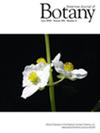Rapid detection of RNase-based self-incompatibility in Lysimachia monelli (Primulaceae)
Abstract
Premise
Primroses famously employ a system that simultaneously expresses distyly and filters out self-pollen. Other species in the Primulaceae family, including Lysimachia monelli (blue pimpernel), also express self-incompatibility (SI), but involving a system with distinct features and an unknown molecular genetic basis.
Methods
We utilize a candidate-based transcriptome sequencing (RNA-seq) approach, relying on candidate T2/S-RNase Class III and S-linked F-box-motif-containing genes and harnessing the unusual evolutionary and genetic features of SI, to examine whether an RNase-based mechanism underlies SI in L. monelli. We term this approach "SI detection with RNA-seq" (SIDR).
Results
The results of sequencing, crossing, population genetics, and molecular evolutionary features each support a causal association linking the recovered genotypes with SI phenotypes. The finding of RNase-based SI in Primulaceae (Ericales) all but cements the long-held view that this mechanism was present in the ancestral pentapetal eudicot, whose descendants now comprise two-thirds of angiosperms. It also significantly narrows the plausible maximum age for the heterostyly evolution within the family.
Conclusions
SIDR is powerful, flexible, inexpensive, and most critically enables work in often-neglected species. It may be used with or without candidate genes to close enormous gaps in understanding the genetic basis of SI and the history of breeding system evolution.


 求助内容:
求助内容: 应助结果提醒方式:
应助结果提醒方式:


